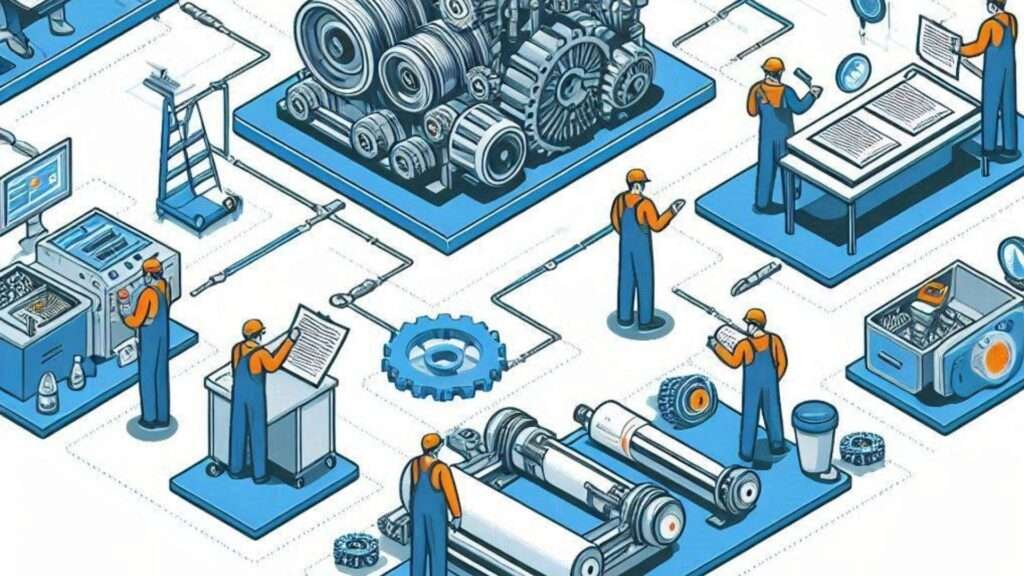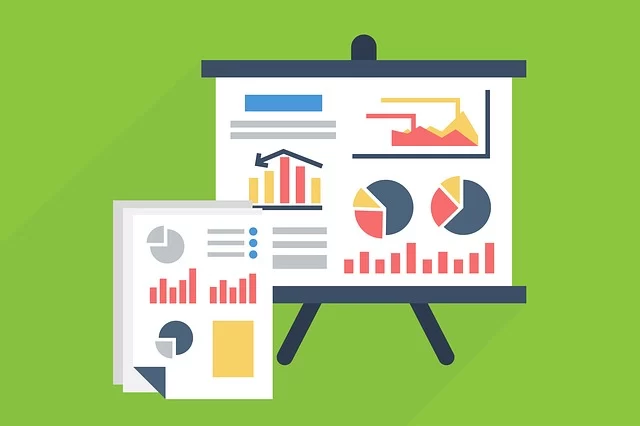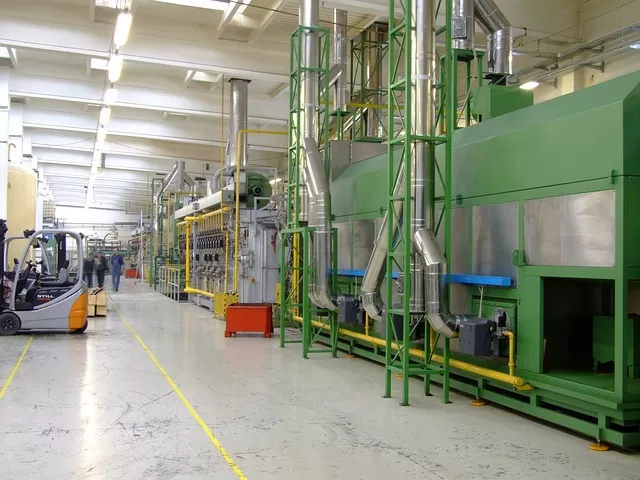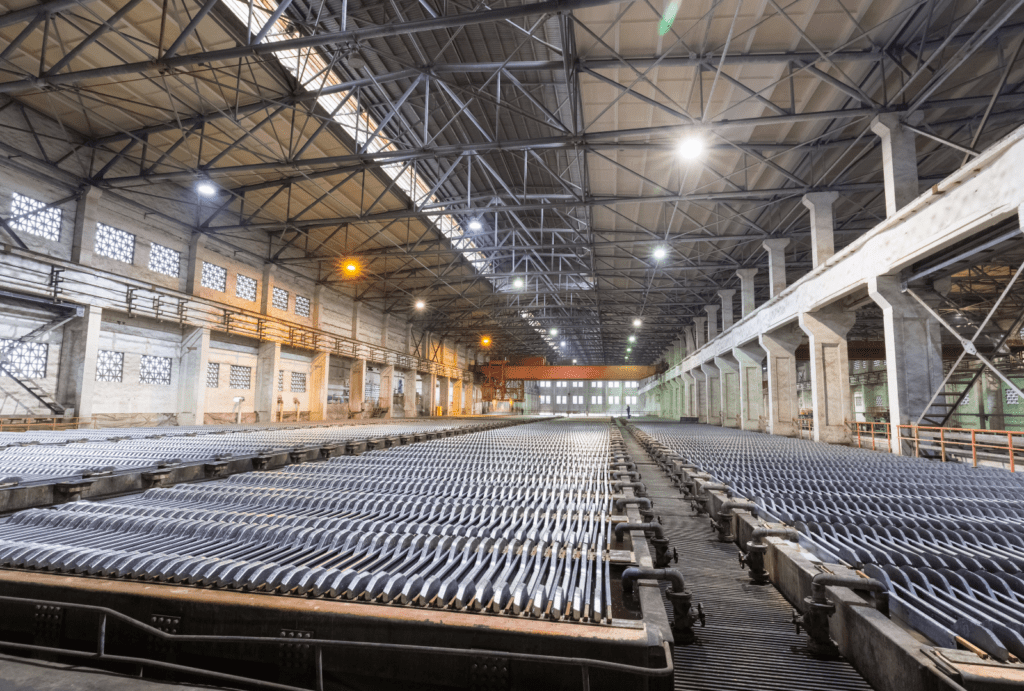Materials Management Quality Is A Common Concern.
Materials management is a critical component of the supply chain that contributes significantly to the success of any business.
It entails planning, organising, and controlling the flow of materials to and within your organisation.
It all boils down to ensuring that the right materials are available at the right time, in the right quantity, of the right quality, and at the right price.
For example, effective material management results in a consistent and dependable flow from suppliers to the warehouse, then to asset maintainers, the production department, and other site users.
Businesses can avoid operational disruptions and maintain high levels of internal customer satisfaction by ensuring that materials are readily available.
This, in turn, leads to increased productivity, reduced costs, and improved overall business effectiveness.
Evaluating Materials Management Effectiveness.
When assessing the effectiveness of materials management in your company, there are several key points to consider:
Is all Starts With Material Availability.
Making sure that materials are available when needed, at the necessary specifications, and in the right quantities is one of the main objectives of materials management.
This entails building trusting relationships with suppliers, accurately forecasting demand, and managing inventories effectively.
Your company can minimise downtime, avoid production delays, and promptly satisfy customer demands by keeping the appropriate materials on hand and making sure that they are fit for use.
Cost Reduction Through Waste Minimisation.
Minimising waste and waste-related expenses is possible with effective materials management.
Your company can lower overhead costs associated with inventory and stop goods from becoming obsolete by not overstocking or understocking materials.
Inadequate planning procedures and practices may also cause materials to be expedited urgently, raising production costs.
Businesses can streamline their procurement procedures, cut lead times, and lessen the need for material expediting by putting effective materials management strategies into place.
The eight forms of waste that are frequently encountered in materials management must also be recognised and dealt with.
These include excess inventory, needless motion, waiting, transportation, improper processing, overproduction, defects, and under-utilised talent.
Interdepartmental Customer Satisfaction.
The smooth movement of materials throughout your company is another key aspect of materials management.
In addition to the acquisition and storage of materials, it involves ensuring the timely delivery of accurate orders to the various internal departments to enhance the overall efficacy of the business.
You can cut down cut down on unnecessary delays and boost production results by making sure that materials are easily accessible to the various departments, most importantly including maintenance and production.
The Recurring Them of Materials Management Concerns.
Over the last 30 years, I’ve had the opportunity to work with a wide range of companies from various industries.
Whether the business was a small single-location operation or a large multi-site global organisation, I’ve noticed a recurring theme of concern, which tends to revolve around issues related to materials management.
In nearly every case, those complaining about materials management issues have stated that they believe the problems with materials management are solely the responsibility of the Supply/Commercial Department.
Over the course of this article, I hope to demonstrate to you that this is rarely the case.
The Feedback: Attempting to Identify the Root Causes.
Through my interactions with employees and contractors at these companies, I have gathered a wealth of valuable feedback, which, after careful analysis, sheds light on why materials management is frequently perceived as lacking.
The common thread among these concerns can be traced back to three critical processes:
1. Master Data Management Quality
2. Cross Department Service Delivery.
3. Critical Systems & Processes Quality.
Master Data Management Quality.
A common challenge that businesses face with materials management is creating and maintaining high-quality master data.
Every work function module of a CMMS/ERP/EAM will have their master data requirements (Maintenance, finance, warehousing, purchasing, inventory, production, safety, environment, transport etc)
Inventory/Material Master Data refers to the essential information about materials, such as their descriptions, specifications, and inventory management criteria.
What you will be perhaps amazed to learn is just how much data can be contained within the material master file.
Some of the Basic Material Data Includes:
I. Classification.
II. Sales.
III. Repairable Indicator.
IV. Purchasing & Purchase Order Text.
V. Material Resource Planning Criteria (lead time, re-order point, minimum order qty, Criticality Assessment, minimum/maximum stock levels, usage, slow moving, potential obsolete calcs etc.)
VI. Forecasting.
VII. Storage Requirements, Stock location & qty.
VIII. Special Handling, Storage & Transportation Instructions.
IX. Size/Dimensions, Weight, Volume.
X. Drawing, Instructional Video and Documentation Attachments.
XI. Environmental Impact Profile.
XII. Warehouse management.
XIII. Quality Management.
XIV. In Stock Maintenance Requirements.
XV. Accounting.
XVI. Data that allows you to use a material at another plant
What you will often and unfortunately find though, is that if you were look at a dozen randomly selected high criticality materials at your business, very little of this information is populated.
Why is Material Master Data Quality Often Lacking Quality?
There are many reasons why this data might be lacking and it is rarely the fault of the people working in this area.
All too often the Supply/Commercial aspects of an operation are seen as an overhead cost that constantly needs to be reduced.
It doesn’t take a lot of thought before you start to realise that if this department has been stripped back to the point to where it can barely function, little time is available to population up to 100 key fields of data for every managed item of warehouse stock.
You might also find that if a company has lacking Material Master Data quality related issues, they are direct purchasing items that should be part of the managed inventory and due to lack of governance in this area, they might even be purchasing items that are catalogued and just don’t trust the systems and processes in place to get the materials to site on time.
The ideal situation is that most material movements involve selecting an inventory item and then requesting the desired quantity, a ‘true’ date required and a delivery point.
Then, if the item selected has been fully and accurately catalogued (all master data populated where possible), the beauty of this is that all considerations that were input into the material master data fields then go to work.
The required actions for getting that material from the supplier to your delivery point on time, in full, at specification and will all quality requirements adhered to is programmatic, very little human interaction is required.
On the other hand, if direct purchasing is the most common method of sourcing materials at your organisation and if you want a desired material to get from the supplier to you without incident, all information that would normally be captured in the material master data file should be physically typed into the ‘additional text’ field of every single purchase requisition.
As you might expect, the chances of getting people to do this would be extremely remote.
So now, we are achieving a better understanding of the importance of material master data.
When this data is inaccurate or incomplete, it can lead to a range of problems, including stock-outs, overstocking, production delays, re-ordering items that were received damaged, re-ordering incorrect specification materials, all of which will ultimately lead to delays in production and negative impact on the business profitability.
We Rarely Use The CMMS/ERP/EAM To Their Full Potential.
It would nice to think that when the purchasing decision was being made for you company’s CMMS/ERP/EAM that those involved with this process were only doing so based on extensive research being conducted.
You would hope that they are taking the long term goals of the business into account and they had had reached out and sought expert advice prior to locking their decision in.
What you may not know is that with a lot of the CMMS/ERP/EAM solutions, there is not just one option to purchase.
You get what you decide to pay for, this goes beyond selecting which modules you would like, it extends to transactions within each module.
In a perfect world scenario, if the users of each module of the CMMS/ERP/EAM populated all of their master data in full and to the highest level of quality, the built-in interconnectivity of the master data would help with ensuring material master data quality and addressing some material management issues at your organisation.
An example of this is when production equipment and components are purchased. There are many occasions where these items need to be created as more than just entries within the asset hierarchy.
Equipment and components with serial numbers that are repairable can be used to make tracked materials within the managed inventory.
The equipment master data of these items can then interact with the associated material master data to achieve enhanced visibility of these items, whether they are on site or offsite being repaired.
There Should Be More Mandatory Direct Purchasing Fields.
All too often direct purchases are made with very little information provided. All arrangements for supply of these items would have been made over the phone and via email and if you are lucky, some of that information will be on the quote and that quote will attached to the purchase requisition and the purchase order that the supplier receives.
This is not a sustainable way of obtaining materials, especially any materials of a critical nature.
The goal has to be to get to a situation whereby direct purchasing is a challenged exception, rather than the rule.
If users are forced to fill out upwards of 75% if the key material master data each time they wish to direct purchase an item, a couple of positive things can potentially happen:
1. Realise It Is Not Worth It: They might realise that it’s probably better to just provide the supply/commercial department with all information to catalogue the item as well as the related work order/cost centre, qty required, date required and their delivery point on site.
a. Then once the cataloguers have finished creating the material master, they can input a request for that material for them.
b. The next time the users need to obtain these items, they will only need to add the material number assigned to a work order, plus the qty and date required or complete a stock request transaction that will only ask for a cost centre/work order, qty, date required and deliver point.
2. Catalogue As You Go: You could employ a person or people to analyse daily/weekly purchase requisitions and use the fact that 75% of the material master data is there for them.
a. They would only need to track down a small amount of information to complete the process.
b. Once the material master was crated, they could advise direct purchase originator of the new material number.
Addressing master data management quality is crucial for companies looking to improve their materials management practices.
Cross Department Service Delivery.
Another significant factor contributing to materials management challenges is the lack of effective cross-department service delivery. Materials management involves multiple departments communicating with each other regarding materials management information.
This includes personnel from procurement, warehousing, transport, logistics, maintenance, engineering, safety, environment, administration to name a few.
When these departments do not work seamlessly together, it can result in delays, miscommunication, inefficiencies, non-compliance situations and financial waste.
For instance, if the supply team does not have clear visibility into production and maintenance schedules, inventory levels and any safety or environmental concerns, they may end up ordering materials either too early, too late or not make critical changes to ensure site compliance remains intact.
Similarly, if there is a breakdown in communication between the maintenance and production departments, it can lead to materials being requisitioned for maintenance events that will not actually happen.
Then waste of time and money is incurred to either send those materials back to the originating suppliers or force the supply team into accepting excess inventory to specification, which adds to the overhead costs on site.
Companies need to foster better collaboration between departments and establish efficient communication on any situation that might possibly affect the overall materials management solution on site.
Critical Systems & Processes Quality.
Effective materials management at your organisation can also be initiated from lacking critical systems and the processes that support these systems.
Sometimes companies rely far too long on outdated or fragmented critical systems to manage their operations. The processes that drive the behaviour of the people that work in various departments can be ineffective and sometimes inaccurate.
These systems may no longer posses the necessary functionalities keep your business processes streamlined, track assets, components & inventory accurately, and provide real-time visibility into materials availability.
Without robust and integrated critical systems in place, companies are going to face challenges in forecasting demand, managing inventory levels, optimising procurement practices, complying to maintenance schedules, delivering on production goals and ensuring that only safe and fit for use materials are every received on site.
Inefficient critical systems can lead to key functions of your businesses not being reliable and this will result in losses across multiple areas and will no doubt affect the bottom line.
Investing in modern critical business management systems can help companies overcome these hurdles and improve their overall production, maintenance and supply chain efficiency and better support the processes that are directly involved with producing the product that warrants the very existence of your business.
Quality critical systems are the glue that binds your organisation together. When all departments on site are working together seamlessly to produce the one common goal, you can better avoid inefficiencies, poor decision making and many avoidable errors that cut away at your profit margin.
Reliably meeting production targets, is not going to happen if you are experienced avoidable materials management & asset management related delays as well as other avoidable disruptions to the manufacturing process that could have been easily avoided if critical systems and processes had prevented actions that led to these situations.
Failure in Critical Systems and process can be avoided by quality master data management and cross department service delivery.
If your site is working with quality data at all times and quality work teams striving to meet their goals and fully support the other departments in achieving their goals, then your critical systems and processes will remain strong.
Assessing Your Company’s Materials Management Processes.
To evaluate your company’s materials management processes, consider asking the following questions within your organisation, which you could use in an internal audit format:
1. Are materials readily available when needed?
Assess whether your business has a reliable system in place to ensure that materials are available when required.
This includes evaluating the accuracy of demand forecasting, the efficiency of procurement processes, and the effectiveness of inventory control measures.
2. Is inventory well-controlled to prevent excess or shortages?
Review your inventory management practices to determine if they are optimised to prevent overstocking or stock-outs.
This involves analysing usage patterns, implementing appropriate inventory control techniques, and regularly monitoring and adjusting inventory levels.
3. How efficient is your procurement process?
Evaluate the efficiency of your procurement process by assessing the time it takes to source and purchase materials.
Look for opportunities to streamline the process, improve supplier relationships, and leverage technology to automate and expedite procurement activities.
4. Is customer satisfaction impacted by material-related issues?
Consider customer feedback and reviews to identify any material-related issues that may be affecting customer satisfaction.
This could include late deliveries, product quality issues, or incorrect shipments.
Addressing these issues can help improve customer satisfaction and loyalty.
The Importance of Effective Materials Management.
Effective materials management systems and processes are crucial for the overall success of a business.
By implementing best practices, monitoring performance, and continuously improving, businesses can achieve optimal results and enjoy some key benefits such as:
a) Improved operational efficiency and productivity
b) Reduced costs through better inventory control and procurement practices
c) Enhanced customer satisfaction through timely delivery and accurate order fulfilment
d) Increased profitability by minimizing stock-outs and excess inventory
e) Better utilization of resources and improved cash flow
Remember, materials management is not a one-time task but an ongoing process that requires constant monitoring and adaptation.
By prioritising effective materials management, businesses can position themselves for long-term success in today’s competitive market.
What’s The Solution For Better Materials Management?
The profitability of a business can be significantly impacted by problems with materials management.
Inefficiencies, higher costs, lost profits, disgruntled customers, and worries from shareholders and business owners can all be caused by inaccurate master data, a lack of cross-departmental coordination, and ineffective critical business systems.
In order to address these problems, organisations need to put a high priority on the quality of their master data, encourage inter-departmental collaboration, and make investments in reliable critical business systems that facilitate efficient management across the board, particularly in the area of materials management.
Deficits in the quality of materials management may originate from one or more departments within your company.
The problems you may experience could be any one or more of the following:
a) Inconsistent quality of master data management.
b) Missing or lacking Bills of Materials.
c) Poor quality & missing business processes and documentation.
d) Lacking Asset & Component specifications.
e) Equipment, Component & Spares criticality determinations.
f) Poor supply demand visualisation.
g) Lacking inter-department scheduling integration.
h) Poor quality performance reporting.
i) Poor material & serialised equipment/component tracking functionality.
j) Absence of positive material identification tools.
k) Lacking repairable item and rotable equipment processes.
l) Lacking critical control functionality.
m) Lacking or missing stock preservation actions.
n) Lacking transport, handling, storage & packaging standards.
o) Lacking warranty claim processes.
p) Not completing regular vendor/supplier audits.
There needs to be a paradigm shift in the way costs associated with supply/commercial departments is viewed.
For my mind, a dollar spend on materials management issues is just as important as a dollar spent on a truck that hauls raw materials.








